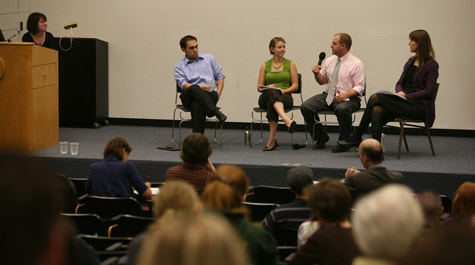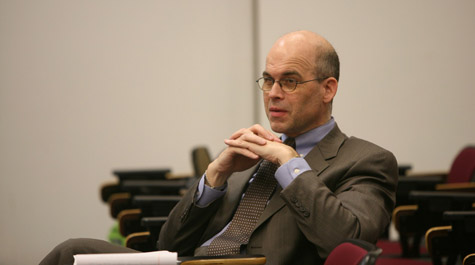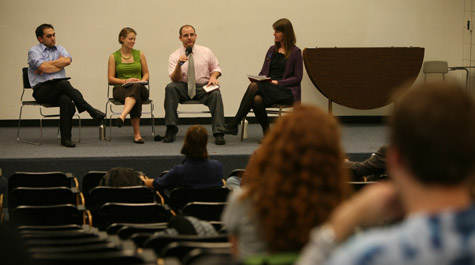Campus conversation: Giving students the tools for success
The student-led discussion, titled “Students Come to William & Mary Wanting to Change the World – Do They Leave with the Tools to Do That?” was the fifth installment in a yearlong discussion on what it means for William & Mary to be liberal arts university in the 21st century. The sessions, convened and hosted by the Office of the Provost, are part of the College’s ongoing strategic planning process. Past conversation topics have ranged from discussing the importance of the College’s professional programs to blending the roles of teaching and research.
The most recent conversation topic comes directly from a portion of the College’s vision statement, which reads that “students come to William & Mary wanting to change the world and will leave with the tools to do it.” Panelists included recent undergraduate alumni, graduate students, undergraduates and an administrator.
“We try to help people figure out how they can impact the world in the areas in which they are invested and passionate about,” said Melody Porter assistant director of the College’s Office of Community Engagement and Service. “In terms of changing the world, starting small is important, and I think we do that in wonderful ways here at William & Mary.”
Tools for life
Moderator Bailey Thompson ’10 kicked off the discussion by asking each panelist the way that William & Mary provided the tools for life after graduation.
Tom Fitzpatrick ’04 J.D. ’10, a recent graduate of the College and a third-year law student, said he asked William & Mary friends on Facebook to help him develop a list of areas where the College excels. He came up with five areas: service, writing, opportunities for leadership, real-world elements in the curriculum and a shared sense of community.
“With these five reasons, we do have the tools to change the world in a way that we see,” he said.
Caroline Cress ’10, a government and environmental studies double major, said the College does especially well on engaging students through real-world applications in academics and research and having a strong extra-curricular program.
“The people that come to this school as students are already people that are really committed. You come here as a William & Mary student. It’s the reputation of this school -- we attract leaders, people who are going to be leaders,” Cress said. “This College also has a great culture of cultivating student organizations and supporting those, and really making a community of activism and service. And that’s the kind of thing that helped me grow.”
However, Cress said, that there were also several institutional factors that the College could improve upon for the future. She would like to see the College continue to take a more active role on issues that remain priorities for students such as diversity and sustainability.
“By creating leaders, it needs to be a leader,” she said. “It needs to give off a sense that it cares about the issues that are going to affect us when we graduate.”
Adam Stackhouse ’10 M.A.’11, said that that the College excels especially in providing the key critical thinking and writing skills that are needed to perform well in any job market.
He cited examples of friends who graduated with one major but ended up finding jobs completely different from their intended field of study.
“This is not because the economy is down and they are not finding jobs they want. This is because their ideas of what they want to do with their lives is changing as they go,” Stackhouse said. “Watching the College evolve over a decade has been interesting, but I think, as a whole, the toolbox for success is there to kind of diverge and look at things other than majors.”
The definition of service
The discussion also focused greatly on the role of service in addition to the importance of faculty-student relationships at William & Mary and the definition of service.
Many of the panelists seemed to have different ideas on what the definition of service should be at the College. Yet in the end, they all seemed to agree that regardless of the definition, its existence was what was most important to the College.
“Service, in the biggest sense of it, is something that you need to succeed in changing the world, and depending on where you’re going in life, William & Mary can prepare you to succeed without preparing you to change the world,” Cress said. “But I really do think that you need to be involved in service in some sense if you really want to change the world.”
Fitzpatrick noted that several of his friends said they never thought much about community service before coming to William & Mary.
“But at William & Mary, community service was cool. It’s cool to go build a house out on the fields by the new dorms. It’s cool to do Peace Corps,” he said.
Looking forward in the 21st century
A final point raised by Thompson asked the panelists how the College, from a student perspective could better meet their needs in the 21st century.
All panelists stressed the need for the College to further work on its diversity initiatives and not only for students, but for all parts of the College, faculty and staff included.
“There are just a lot of seeds planted waiting to burst,” Porter said. “But they need a little more attention, thoughts and care. I think we’re going in the right direction with that.”
The next campus conversation will focus on “Changing Understandings of Liberal Education” and will include a presentation by Carol Geary Schneider, president of the Association of American Colleges and Universities. The event will take place April 2 at 2 p.m. in the Sadler Center’s Chesapeake C room. For more, visit http://www.wm.edu/conversation.

















